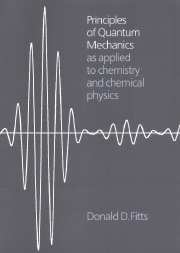Book contents
- Frontmatter
- Contents
- Preface
- Chapter 1 The wave function
- Chapter 2 Schrödinger wave mechanics
- Chapter 3 General principles of quantum theory
- Chapter 4 Harmonic oscillator
- Chapter 5 Angular momentum
- Chapter 6 The hydrogen atom
- Chapter 7 Spin
- Chapter 8 Systems of identical particles
- Chapter 9 Approximation methods
- Chapter 10 Molecular structure
- Appendix A Mathematical formulas
- Appendix B Fourier series and Fourier integral
- Appendix C Dirac delta function
- Appendix D Hermite polynomials
- Appendix E Legendre and associated Legendre polynomials
- Appendix F Laguerre and associated Laguerre polynomials
- Appendix G Series solutions of differential equations
- Appendix H Recurrence relation for hydrogen-atom expectation values
- Appendix I Matrices
- Appendix J Evaluation of the two-electron interaction integral
- Selected bibliography
- Index
- Physical constants
Chapter 8 - Systems of identical particles
Published online by Cambridge University Press: 05 June 2012
- Frontmatter
- Contents
- Preface
- Chapter 1 The wave function
- Chapter 2 Schrödinger wave mechanics
- Chapter 3 General principles of quantum theory
- Chapter 4 Harmonic oscillator
- Chapter 5 Angular momentum
- Chapter 6 The hydrogen atom
- Chapter 7 Spin
- Chapter 8 Systems of identical particles
- Chapter 9 Approximation methods
- Chapter 10 Molecular structure
- Appendix A Mathematical formulas
- Appendix B Fourier series and Fourier integral
- Appendix C Dirac delta function
- Appendix D Hermite polynomials
- Appendix E Legendre and associated Legendre polynomials
- Appendix F Laguerre and associated Laguerre polynomials
- Appendix G Series solutions of differential equations
- Appendix H Recurrence relation for hydrogen-atom expectation values
- Appendix I Matrices
- Appendix J Evaluation of the two-electron interaction integral
- Selected bibliography
- Index
- Physical constants
Summary
The postulates 1 to 6 of quantum mechanics as stated in Sections 3.7 and 7.2 apply to multi-particle systems provided that each of the particles is distinguishable from the others. For example, the nucleus and the electron in a hydrogen-like atom are readily distinguishable by their differing masses and charges. When a system contains two or more identical particles, however, postulates 1 to 6 are not sufficient to predict the properties of the system. These postulates must be augmented by an additional postulate. This chapter introduces this new postulate and discusses its consequences.
Permutations of identical particles
Particles are identical if they cannot be distinguished one from another by any intrinsic property, such as mass, charge, or spin. There does not exist, in fact and in principle, any experimental procedure which can identify any one of the particles. In classical mechanics, even though all particles in the system may have the same intrinsic properties, each may be identified, at least in principle, by its precise trajectory as governed by Newton's laws of motion. This identification is not possible in quantum theory because each particle does not possess a trajectory; instead, the wave function gives the probability density for finding the particle at each point in space. When a particle is found to be in some small region, there is no way of determining either theoretically or experimentally which particle it is.
- Type
- Chapter
- Information
- Principles of Quantum MechanicsAs Applied to Chemistry and Chemical Physics, pp. 208 - 231Publisher: Cambridge University PressPrint publication year: 1999

